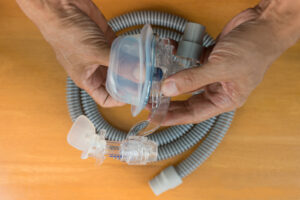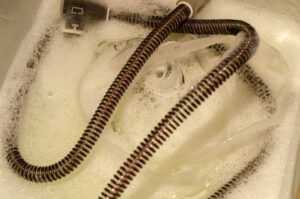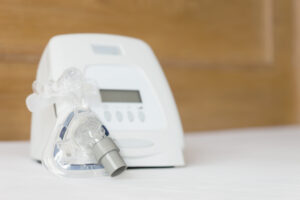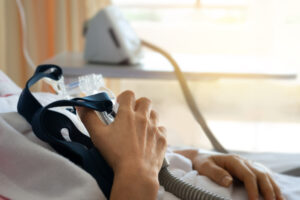CPAP stands for continuous positive airway pressure and is one the most common treatments for obstructive sleep apnea. If you’ve shopped around for sleep apnea treatments, you may have come across other acronyms like BiPAP or APAP, which are variations on the traditional CPAP. We explain the differences between each type of PAP, the instances in which they are used, and the overall benefits of PAP therapy.
What Is PAP Therapy?
Positive airway pressure (PAP) machines treat obstructive sleep apnea by delivering a stream of pressurized air through a face mask while you sleep. The goal of this treatment is to keep open the airway that leads to your lungs, preventing air flow obstructions that are characteristic of sleep apnea.
Types of PAP Therapy
When it comes to PAP therapy, there are several different types of machines. Some machines put out consistent air pressure at all times, while others can switch between multiple pressure levels.
CPAP
Continuous positive airway pressure (CPAP) is the oldest, simplest, and most common type of PAP therapy. Like all types of PAP therapy, CPAP machines continuously deliver air through a mask to prevent airway blockages. Typically CPAP machines deliver air at a fixed pressure level throughout the night.
A CPAP machine’s fixed pressure level is selected based on the results of an overnight PAP titration study during which different pressure settings are tested during sleep and the lowest effective pressure is selected. Pressure needs to be just high enough to maintain healthy breathing during moments when the airway would otherwise get blocked. The pressure level can be changed again in the future if needed, but the machine can only provide one constant pressure setting at a time.
BiPAP
BiPAP or BPAP refers to bilevel positive airway pressure therapy. Unlike fixed-level CPAP, BiPAP alternates between two different pressure levels:
- Inspiratory PAP (IPAP), the air pressure during the sleeper’s inhale
- Expiratory PAP (EPAP), the air pressure during the sleeper’s exhale
Generally, BiPAP is set up to provide higher air pressure when inhaling than exhaling, which some people may find more comfortable than a constant pressure level.
The machine senses whether the person is inhaling or exhaling, responding with the appropriate pressure level.
APAP
Auto-adjusting positive airway pressure (APAP) doesn’t rely on fixed pressure levels. APAP can operate at a range of pressure levels, automatically adjusting within this range to meet the sleeper’s needs.
Sensors pick up on the APAP user’s breathing patterns and use algorithms to match the pressure level accordingly. If someone’s breathing starts to slow or pause, the machine responds with increased air pressure to correct the issue.
Both CPAP and BiPAP can be equipped with auto-adjusting technology. This added tech may make the experience more comfortable for the sleeper by only supplying higher pressure air when it’s most needed.
What Are the Benefits of PAP Therapy?
PAP therapy is currently the best treatment available for sleep apnea, providing many benefits when used regularly:
- Better sleep quality
- Less snoring
- Improved mental health
- Better daytime alertness
- Improved blood pressure
- Improved quality of life
- Reduced risk of car accidents, stroke, and heart and lung complications
Another advantage of PAP machines is the ability to adjust the treatment to meet personal needs and preferences. The variety of types of PAP machines, features, and masks allows people to find the right fit for them to achieve healthy and comfortable sleep.
Choosing the Best PAP Therapy
Choosing the best PAP therapy will depend on your preferences, practical needs, and health needs. Speak with a medical professional to determine which type of PAP therapy may be the best fit.
When to Choose CPAP
As the oldest and most heavily studied type of PAP, fixed-level CPAP is the traditional first-line choice if you’ve never used a PAP machine. You’ll also find it’s the least expensive option, a great choice if the single pressure level works for you.
When to Choose APAP
While APAP may cost slightly more than fixed-level CPAP, these machines could be a great choice for people who find CPAP uncomfortable. Unlike CPAP or BiPAP, APAP machines don’t require an overnight stay at a sleep lab for initial setup, so it’s a good option when a sleep lab visit isn’t accessible or feasible.
When to Choose BiPAP
BiPAP can be an option for people who experience pressure intolerance at higher CPAP settings.. Most others with sleep apnea don’t use BiPAP unless they’ve tried CPAP and APAP first.
References
Get Your Sleep Questions Answered Live on 4/30
Have questions about sleep? Get all your sleep-related questions answered in a Live Q&A on YouTube with renowned sleep expert Dr. Michael Breus at 5 p.m. PST/8 p.m. EST.










